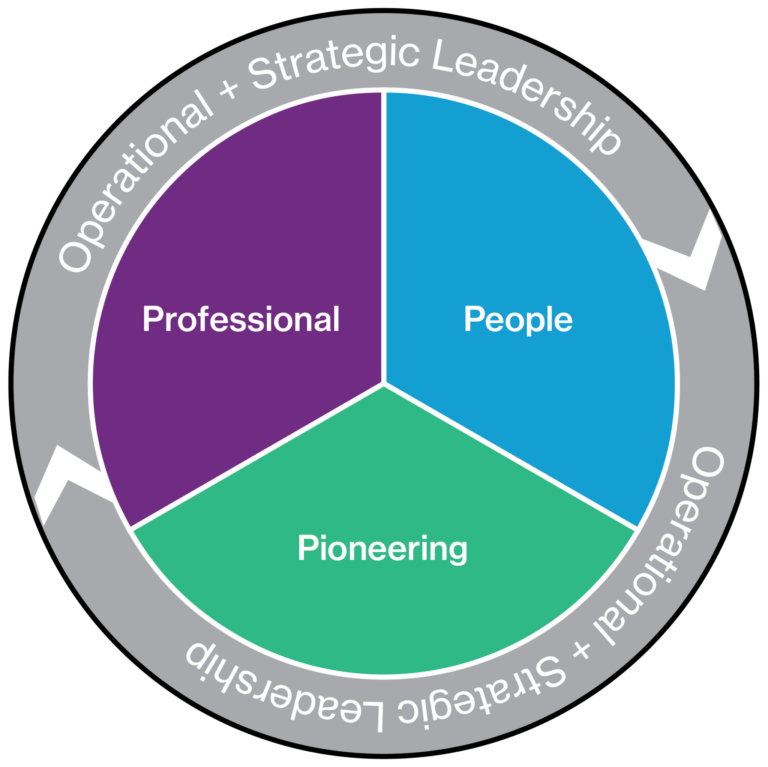Article · 5 minute read
Creating Career Tracks & Engaging a Wider Talent Pool
By Hannah Mullaney – 6th June 2022
In our first article of the series, we suggested that traditional models of potential can be very restrictive in terms of what they say and measure. They tend to present one very clear definition of potential that applies to leadership across all organizations and fail to account for different types of leadership roles.
What Does the Data Say?
In developing our own model of leadership, we analyzed a lot of data that pointed clearly towards the idea that there were three broad types of leadership: Professional leadership, People leadership and Pioneering leadership.


Professional
Professional leaders are likely to be effective at leading in specialist contexts, focusing on reputation and providing technical knowledge.
People
People leaders are likely to be effective at managing a wide range of people across teams, functions and geographies.

Pioneering
Pioneering leaders are likely to be effective at identifying new opportunities, driving change and achieving growth.
We find that most leadership roles require a combination of two of these three areas, although some will focus on one and others occasionally will need a combination of all three. Lower level or operational leadership roles tend to need a combination of Professional and People leadership, with a shift to a combination of People and Pioneering leadership for more senior or strategic leadership. Whilst it is rare that one leadership role will focus on all three of these areas, what is clear is that a leadership team must have strong coverage across them and that gaps come with risks.
It follows, then, that a leadership pipeline should also have strong coverage across these three areas. Leadership potential identification processes should use the opportunity to measure this, seek to understand where they might be gaps and then look to implement strategies to fill these gaps. We believe there are two main advantages for doing this:
Post-pandemic leadership pipelines: Get them ready for anything
Leadership pipelines today need to be flexible and agile enough to allow organizations to pivot in any direction at any time. Hospitality and retail businesses focused on growth pre-pandemic had their customer base whipped from under them pretty much overnight and, in order to survive, they needed to pivot to managing risk and keeping staff informed. Instead of Pioneering leaders pushing growth, they suddenly needed Professional and People leaders to really come to the fore.
Supermarkets that comfortably made millions by very efficiently providing lots of food to lots of people suddenly had to deal with unprecedented supply chain and staffing issues. Professional, People and Pioneering leaders would have all been critical here. And many manufacturing businesses fought back against a suddenly empty order book by reinventing themselves as PPE producers, when they might have made dresses, snowboards or whiskey before. They wouldn’t have been able to do this with just Professional leadership.
By ensuring your leadership pipeline has healthy coverage across these areas, you are protecting the organization from not having the right leadership in the future, whatever that future may be, and we believe this should be a critical part of any high-potential identification process.
Engaging the many, not just the few
Capturing data that provides an indication of someone’s ‘Professional’, ‘People’ or ‘Pioneering’ potential also helps widen the opportunity for development and sometimes even progression outside of what is often an exclusive cohort. Career tracks can be laid for everyone, whether identified as high potential or not (which leaves you with no excuse not to run an open and transparent process).
A recent survey illustrated that 57% of organizations accept 20% or less of nominations on to their leadership programs. This means you are left with a situation where you are technically rejecting more people than you are accepting. However, unlike a recruitment campaign, the unsuccessful individuals are already employees, so careful consideration is needed. Telling someone you don’t class them as high potential is incredibly disengaging and potentially damaging.
Being able to position the program as something that helps everyone understand what their career path may look like provides a framework for positive development planning and career conversations outside of the limited ‘hi-po’ group. This means that your process actually has the opportunity to engage everyone. It also strengthens organizational structures by developing people towards places they can add real value, outside of that very exclusive top tier.
How Can We Help?
Our tools can help you identify, develop and engage top talent for your organization. Get in touch to find out more.